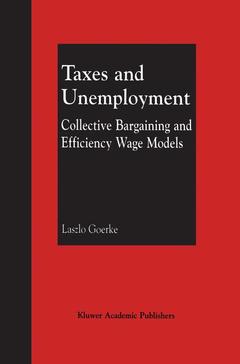Taxes and Unemployment, Softcover reprint of the original 1st ed. 2002 Collective Bargaining and Efficiency Wage Models
Langue : Anglais
Auteur : Goerke Laszlo

This chapter has set out in detail the models which are employed below in order to analyse the labour market effects of changes in tax rates and in alterations in the tax structure. The fundamental mechanisms underlying the different approaches have been pointed out. Moreover, vital assumptions have been emphasised. By delineating the models which are used for the subsequent analyses, implicitly statements have also been made about topics or aspects which this study does not cover. For example, all workers and firms are identical ex ante. However, ex-post differences are allowed for, inter alia, if unemploy ment occurs or if some firms have to close down. These restrictions indicate areas of future research insofar as that the findings for homogeneous workers or firms yield an unambiguous proposal for changes in tax rates or the tax structure in order to promote employment. This is because it would be desir able for tax policy to know whether the predicted effects also hold in a world with ex-ante heterogeneity. Furthermore, the product market has not played a role. Therefore, repercussions from labour markets outcomes on product demand - and vice versa - are absent. 55 Moreover, neither the process of capital accumulation, be it physical or human capital, nor substitution pos sibilities between labour and capital in the firms' production function are taken into account. Finally, international competition is not modelled.
1 Aims and Scope.- 2 Basic Models.- 2.1 Fundamental Assumptions.- 2.2 Competitive Labour Maekrt.- 2.3 Union-Firm Interaction.- 2.4 Efficiency Wage Models.- 2.5 Summary.- 3 Income Taxes.- 3.1 Introduction.- 3.2 Compertitive Labour Market.- 3.3 Wage Bargaining with Exogenous Trade Union Membership.- 3.4 Efficient Bargaining.- 3.5 Wage Bargaining with Endogenous Trade Union Membership.- 3.6 Efficiency Wages.- 3.7 Income Taxes in Imperfectly Competitive Labour Markets.- 4 Taxes on Labour Costs.- 4.1 Introduction.- 4.2 Competitive Labour Market.- 4.3 Wage Bargaining with Exogenous Trade Union Membership.- 4.4 Efficient Bargaining.- 4.5 Wage Bargaining with Endogenous Trade Union Membership.- 4.6 Efficiency Wages.- 4.7 Taxes on Labour Costs in Imperfectly Competitive Labour Markets.- Appendix to Chapter 4.- 5 Tax on Revenues.- 5.1 Introduction.- 5.2 Competitive Labour Market.- 5.3 Wage Bargaining with Exogenous Trade Union Membership.- 5.4 Efficient Bargaining.- 5.5 Wage Bargaining with Endogenous Trade Union Membership.- 5.6 Efficiency Wages.- 5.7 Tax on Revenues in Imperfectly Competitive Labour Markets.- 6 Comprehensive Tax Reforms.- 6.1 Introduction.- 6.2 The Wedge between Labour Costs and Net Wages.- 6.3 Value-added Tax versus Social Security Contributions.- 6.4 On Tax Reforms.- 7 Policy Implications.- Symbols and Abbreviations.- References.
Date de parution : 10-2012
Ouvrage de 302 p.
15.5x23.5 cm
Date de parution : 11-2001
Ouvrage de 302 p.
15.5x23.5 cm
Thème de Taxes and Unemployment :
© 2024 LAVOISIER S.A.S.



